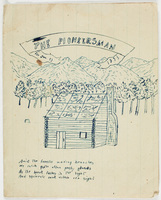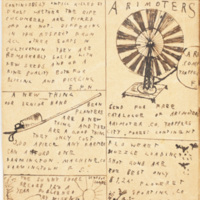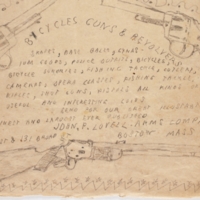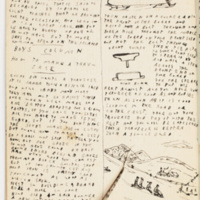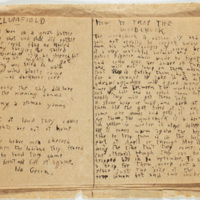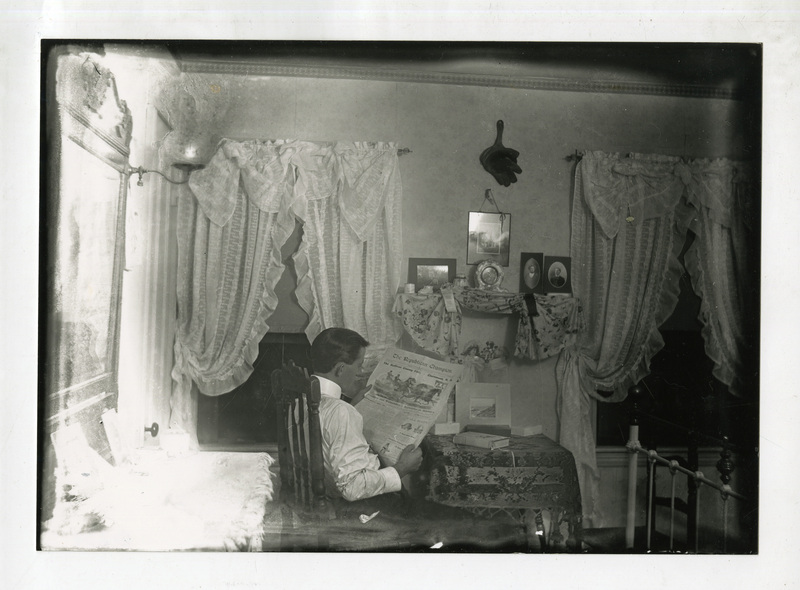Periodicals
My library should also be regularly supplied with several of the standard magazines...No reader is fully abreast of the times unless he or she keeps track of what is going on both at home or abroad, and there is no way which it can be better done than by reading current magazines
- Elmer Nelson, in his 1899 essay, "My Library"
While the Nelson brothers evidently put a good deal of effort into producing works for their collection of storybooks, they were also prolific periodical authors and admired the immediacy and reach of the periodical press, as evidenced by the quote above. The boys produced general papers as well as magazines and newspapers focused on smaller sectors of the population. For example, the information in War News: Jan. 19, 1895, Nov. 13, 1896, June 24, 1895 evidently catered to those interested in combat (and interestingly, sports), while Chit Chat: (December, January, February, undated) is geared towards young readers. Since evidence from the Goshen Historical Society suggests that the boys had access to The Youth’s Companion, a popular juvenile publication of the 19th and early 20th centuries, one can postulate that papers like these greatly influenced the style and layout of their own periodicals.
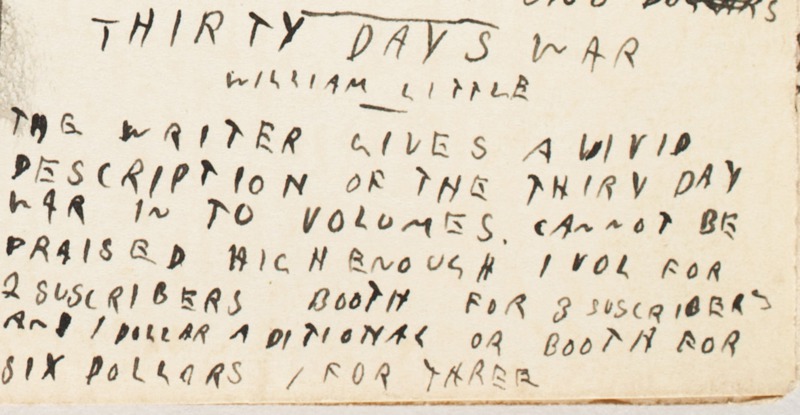
This ad, taken from the Jan 12, 1893 issue of Chit Chat, is for one of the books written by the boys (under the pseudonym of William Little).
Advertisements
The advertisements contained in the boys’ publications give much insight into the boys’ business acumen and attention to detail. In contrast with more modern periodicals, the commercial portions of some of their papers are confined to the last few pages of each issue. This style does not seem to be a creation by the boys; The Youth's Companion employs a similar structure with their layout. Other papers, however, are more commercial in nature and feature ads throughout. The Nelsons were very aware of their audience: the ads in The Youth's Companion are often centered around toys and materials that would interest children, while those in Intellectual Farmer focus on seeds and plants for those involved with agriculture. The boys are careful, too, about keeping within the realm of the world they have created. They often used their magazines to advertise other of thier publications, the subject of one advert in an issue of Chit Chat is the boys’ own book, Thirty Days War by William Little. The advertisement not only bestows praise, but demonstrates a complex marketing strategy--offering the book in exchange for signing up subscriptions to the magazine:
“The writer gives a vivid description of the Thir[t]y Day War in t[w]o volumes. Cannot be praised high enough 1 vol for 2 suscribers booth for 3 suscribers and 1 dollar aditional or booth for six dollars for three” (Chit Chat – Jan. 12, 1893)
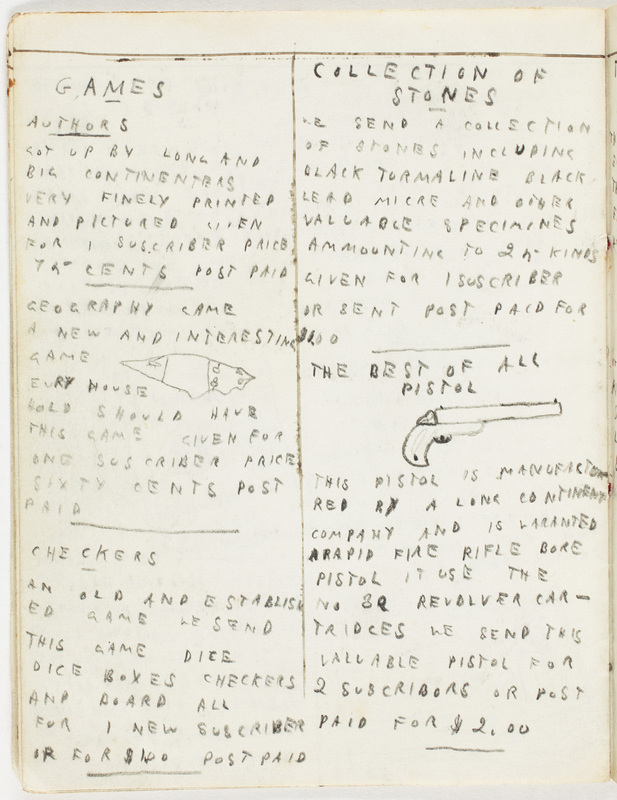
This page of ads from an issue of Chit Chat features many games and items of interest for the adolescent population.
One advertisement, found on the back cover of The Canoe and Rifle, is of particular interest. The store being publicized was a real store in Boston. The gun drawings found in the promotional material appear quite similar to images found in a 1890s catalog from the company. Thus, when the boys advertised products different from their own, they aspired to advertise them in the same way that the real company would.
Fictional Stories
Much like those stories found in the Nelson boys’ books, those found in their periodicals also focus on their favorite subjects (including farming, hunting, and voyaging). The most significant difference between the stories is in their presentation. Within the periodicals, particularly Chit Chat and the eight issues of The Pioneersman (1, 2, 3, 4, 5, 6, 7, 8), stories are often divided into installments. This way, readers must purchase the subsequent issue or two in order to complete the story. This multi-installment method mirrors that of The Youth’s Companion; it also reinforces the boys’ business insight. Since the boys did not always produce as many works as they might have set out to do, their stories in their periodicals are not always complete.
However, there are a few examples that do, in fact, have at least two parts available in the collection. Take, for example, “The Treasure of Oval Mountain” in The Pioneersman (Dec. 26, 1892 and Jan. 13, 1893 issues). The available installments do not appear to line up (and the issue numbers are not successive), suggesting that the second part of the story was written in a missing issue. Nonetheless, the available materials give insight into the boys’ writing process. The first part is almost entirely description and background about Oval Mountain. However, by the end of the installment, the author begins to build some suspense: a character named Mr. Beam begins to tell how he attempted to rescue his lamb from a panther on the mountain. The section ends abruptly at a moment of suspense and danger:
“I kept on up the mountain and after a while neared the summet all at once as I was thinking that I had better turn round and go back I heard a growl come from a bunch of bushes and when I look that way I saw a large crouching animal that I knew was a panther.”
The lamb’s fate, as well as that of the panther, remains ambiguous, prompting readers to eagerly await the next installment. The third part, available in the Jan. 13, 1893 edition, ends in a similar fashion; the two boys, Jack and Tom, have gotten themselves into a similar predicament on Oval Mountain. They remember Mr. Beam’s story in fear and attempt to sleep before executing their escape.
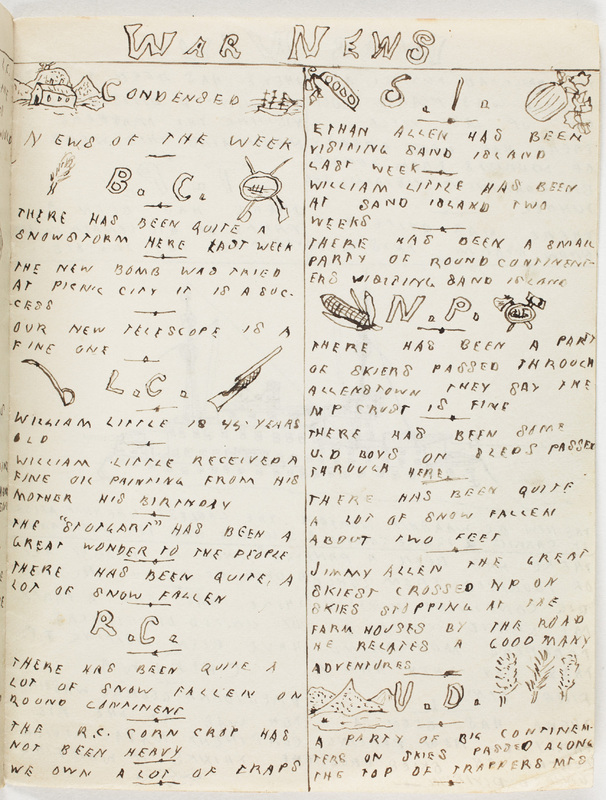
War News provides "condensed news of the week" for the imaginary continents--including a new bomb on Big Continent.
World News
In addition to fictional stories, the boys also include historical accounts and brief biographies of events and individuals from their imaginary world. War News: Jan. 19, 1895, Nov. 13, 1896, June 24, 1895 deals entirely with reporting on battles taking place between the continents as well as reviewing new battle technologies, so allusions to the boys’ alternate identities are rampant in these issues. The front page headline from the June 24, 1895 issue reads, “A Great Battle: It has shaken the whole world. Nearly a victory for L.C.”. The article tells the story of the “greatest battle ever fought on land or on water” in which William Little fearlessly led his troops against the soldiers of Big Continent. The magnitude of the numbers utilized in the article, in addition to the attention-grabbing headline and superlatives throughout, demonstrate the boys’ ability in producing sensationalist pieces of writing.
However, not all of the articles written about imaginary people and places are as dramatic as these. The Pioneersman often contains short biographical pieces about certain individuals. For example, one issue contains the background information of Geo Washington, a man with inspirations of building a new republic (The Pioneersman – Dec. 16). One issue of The Weekly Telegram contains a column about Mr. J. Silver, who is described as being “the stingiest man in the world” (The Weekly Telegram – Jan 23, 1895).
To further build on the history of the imaginary continents and their inhabitants, many of the papers also have a “Condensed News of the Week” section on the last page (or pages. Typically organized by location, these short blurbs give readers updates on various current events. In one issue of The Weekly Telegram, a particular section takes up the majority of the paper. Blurbs range from updates on weather – under “New Poplington News,” the first sentence reads “It was very cold here last week Monday and Tuesday” – to updates on products produced by the place – “Willow News” tells how “The Green Ville sugar refinery took off 100,000,000 gallons of syrup to day March 30” (The Weekly Telegram – April 19, 1894). Mountain News (Feb. 5th, Jan. 30th, Mar. 7th, March 11th, undated, and undated (2) also dedicates a great deal of space to these brief updates. They greatly add to the dimensionality of these imaginary places. Not only does each of the continents have a written history, but each also has records of events occurring in (imaginary?) real-time.
Newspaper Clippings
Two of the boys’ publications, The Trapper and War News Scrapbook, are comprised solely of newspaper articles from established papers during the 1890s. As evidenced in The Youth’s Companion (June 5, 1884) in an article called “One Way of Making a Scrap-Book,” scrapbooking was a popular pastime for children during the late 18th century. Scrapbooks allowed for the collection and organization of interesting articles; in particular, the article calls attention to how “there is a pleasurable excitement…in acting as one’s own editor, accumulating material from every field of literature.”
Interestingly, the content of the two different scrapbooks do not seem to differ all that much. While the War News Scrapbook does contain some articles involving warfare or organized troops, there are also articles taken from The Youth’s Companion that have nothing to do with battles whatsoever. Stories like “Attacked by Wolves,” found in the July 21, 1891 edition of The Trapper, appear to be possible sources of inspiration for the boys’ creations. Not only have the boys elected to save long articles; they also have pasted various poems and brief articles or quotations. One brief article in The Trapper records the text from two epitaphs; little else is analyzed or mentioned.
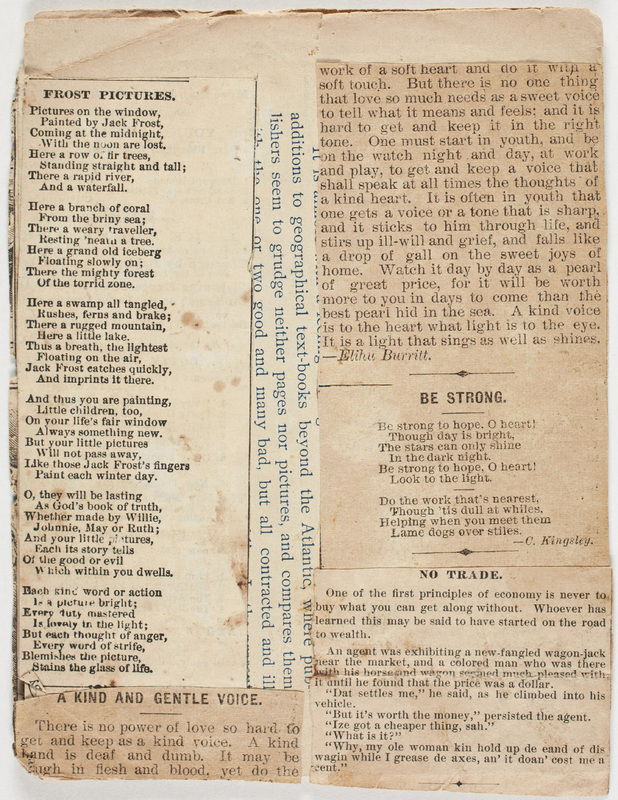
This excerpt from The Trapper contains a couple of poems, economic advice, and interestingly for the Nelsons, a moral story about maintaining a "kind and gentle voice," as well as a book review running sideways.
The scrapbooks are of special note not only because they provide additional insight into the boys’ interests in particular topics, but also because they demonstrate their reading of periodicals, and their interests in collecting and organizing materials. The fact that the Nelsons devoted time to cutting out and pasting such articles reinforces their interest in preserving history, be it their own or someone else’s.
Miscellaneous
As previously suggested, the similarities in structure and content between the Nelsons’ papers and that of The Youth’s Companion are quite evident. Certain issues of Chit Chat have a section, either titled “Children’s Column” or “Boys’ Column.” The latter was added to The Youth’s Companion as a recurring column in the 1900s, but the “Children’s Column” was most certainly a routine part of each issue during the 1890s; during the latter half of the decade, the section grew to cover a whole page of the paper. Essentially, these sections were written for a younger audience. In Chit Chat, these columns are dedicated to poetry, written by one of a number of fictional authors. The “Boys’ Column” section involves a how-to of some sort. In the Jan. 12, 1893 issue of the paper, the subject of choice is a traverse, an upscale version of a sled. These decisions to address certain readers differently are consistent with the boys’ detailed sense of a literary marketplace catering to differnt sorts and ages of readers.
Poems abound in the Nelsons’ periodicals, even aside from the “Children’s Column.” Each issue of Chit Chat (December, January, February, undated) seems to begin with a small poetic musing, and others can be found throughout. For example, the cover of the December issue has the following poem:
“The sun shines Bright and the wind
Blows strong
While we go merily sailing along.”
Poetry was a regular feature of most 19th century periodicals and it seems to have been an important part of the Nelson household; in Sketches of Our Home Life Vol. 1, Ida includes poetry as one of the subjects discussed during their family Lyceums.
List of Periodicals Produced by the Nelson Brothers
- The Canoe and Rifle- Chit Chat:(December, January, February, undated)- Horse Rase- The Intellectual Farmer: March and April- The Little City Democrat & Trapper- Mountain News (Feb. 5th, Jan. 30th, Mar. 7th, March 11th, undated, undated (2)- The Pioneersman (1, 2, 3, 4, 5, 6, 7, 8)- Sunny Shore Record- The Trapper- War News: Jan. 19, 1895, Nov. 13, 1896, June 24, 1895 issues- War News Scrapbook- The Weekly Telegram: Sept 1.(Sample Copy),March 1894,April 19, 1894 , Jan 23, 1895, undated
- The Western World: (Easter Number), Undated
